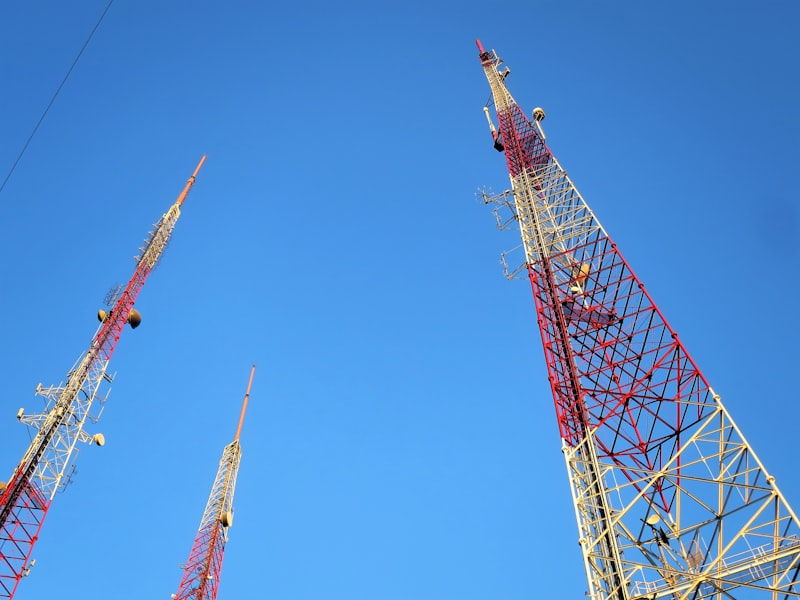In the not-so-distant future, telecommunications will cease to be just about making calls or sending texts. It’s evolving into an interconnected web where everything from your refrigerator to your car will be seamlessly integrated, communicating data faster than you can blink.
Imagine a world where your morning routine is synced with your home’s smart devices. Your alarm not only wakes you up but also adjusts the thermostat and starts brewing your coffee – all through a simple command to your virtual assistant. This interconnectedness is what the future of telecommunications promises – a world where devices talk to each other in real-time, anticipating your needs before you even realize them.
5G technology is the backbone of this revolution. It’s not merely an upgrade from 4G; it’s a quantum leap. With speeds up to 100 times faster than its predecessor and almost negligible latency, 5G will enable technologies like autonomous vehicles and remote surgery to become commonplace. Imagine a surgeon in New York performing a delicate operation on a patient in Sydney with precision and real-time responsiveness – that’s the power of 5G.
But it’s not just about speed. The future of tech in telecom also lies in artificial intelligence (AI) and machine learning. These technologies will not only enhance network management and security but also personalize user experiences like never before. Your phone will learn your habits, predict your preferences, and adapt accordingly, making your digital interactions more intuitive and efficient.
Moreover, the Internet of Things (IoT) will be at the heart of this transformation. From smart cities to smart homes, billions of devices will be interconnected, creating a vast network of data that will drive efficiencies and unlock new possibilities across industries. Imagine sensors in agricultural fields monitoring soil moisture levels and automatically triggering irrigation systems when needed, optimizing crop yields and conserving water – that’s the potential of IoT in telecom.
5G Revolution: How Next-Gen Networks Will Redefine Telecommunications
5G stands for fifth-generation cellular network technology, the successor to the current 4G LTE networks we use today. Unlike its predecessors, 5G isn’t just an incremental improvement; it’s a quantum leap forward. Think of it as upgrading from a country road to a superhighway where data travels at lightning speed.
One of the most striking features of 5G is its speed. We’re talking about download speeds up to 100 times faster than 4G LTE. Imagine downloading a full-length HD movie in seconds or streaming 4K videos without any buffering. This speed isn’t just for your smartphone; it extends to all connected devices, from smart home gadgets to autonomous vehicles.
But speed is just the tip of the iceberg. 5G also promises incredibly low latency, which is the time it takes for a device to communicate with another device over the network. This near-instantaneous responsiveness opens up possibilities we’ve only dreamed of until now. Industries like healthcare, manufacturing, and entertainment will see transformative changes. Surgeons could perform remote surgeries with precision, factories could be fully automated with minimal human intervention, and augmented reality experiences could become seamless and immersive.
Moreover, 5G networks are designed to handle a massive number of connected devices simultaneously, without compromising performance. This means no more network congestion during peak hours or at crowded events. Your smart city infrastructure, including traffic lights and public transportation systems, will operate more efficiently, making urban life safer and more sustainable.
The 5G revolution isn’t just about faster smartphones; it’s about ushering in a new era of connectivity that will redefine how we live, work, and interact with the world around us. As this technology continues to roll out globally, brace yourself for a future where the unimaginable becomes reality, thanks to the power of 5G.
AI and IoT: Transforming Telecommunications Infrastructure for Tomorrow
AI, with its ability to analyze massive amounts of data at lightning speed, is the brain behind IoT’s interconnected network of devices. It enables these devices to communicate, learn from user behaviors, and make decisions autonomously. This synergy is not just about convenience; it’s about efficiency and reliability on a scale we’ve never seen before.
In telecommunications, AI and IoT are paving the way for smarter networks. Picture a network that can predict and prevent outages before they occur, thanks to AI algorithms monitoring data patterns in real-time. This proactive approach ensures that disruptions are minimized, keeping businesses and individuals seamlessly connected.
Moreover, AI-powered analytics enhance network security, identifying and thwarting potential cyber threats before they compromise data integrity. This level of preemptive security is crucial in an increasingly interconnected world where the volume of sensitive data being transmitted continues to grow exponentially.
On the consumer side, AI and IoT are enhancing user experiences like never before. From personalized recommendations based on past behaviors to smart home devices that adjust settings automatically, these technologies are making life more convenient and efficient. Imagine walking into your home, and the temperature adjusts to your liking automatically, while your favorite music starts playing—all thanks to AI and IoT working together in perfect harmony.
From Fiber Optics to Quantum Communication: The Evolving Backbone of Telecom
Fiber optics, once the pinnacle of data transmission technology, uses light pulses to carry information over long distances through thin strands of glass or plastic fibers. Its development enabled high-speed data transfer, revolutionizing telecommunications globally. Imagine it as a superhighway where information zooms through at the speed of light, connecting continents, cities, and homes seamlessly.
However, as technology continues to push boundaries, quantum communication emerges as the next frontier. Unlike traditional methods that rely on light particles (photons) to transmit data, quantum communication leverages the unique properties of quantum mechanics. It utilizes quantum bits or qubits, which can exist in multiple states simultaneously, offering unparalleled security and efficiency.
One of the most mind-boggling aspects of quantum communication is its potential to enable completely secure transmissions through quantum encryption. This means data can be transmitted in such a way that any attempt to intercept it would alter its quantum state, alerting both sender and receiver to the breach. It’s like sending a message in a lockbox that changes its lock instantly if tampered with.

Moreover, quantum communication promises faster-than-light information transfer, although still in experimental stages, indicating a future where communication could be instantaneous over vast distances. It’s akin to teleporting information across the globe at the blink of an eye, making current data transfer speeds seem sluggish in comparison.
Edge Computing: Reshaping Telecommunications for Low-Latency Applications
Traditionally, data from our devices travels long distances to centralized data centers for processing. This journey introduces latency, a delay that can affect real-time applications like video streaming, online gaming, and autonomous vehicles. Edge computing flips this model on its head by decentralizing data processing. It places mini data centers closer to the source of data, whether it’s a smart city sensor, a factory robot, or a mobile device.
Think of it as having a local bakery versus ordering bread from across town. With the bakery nearby, you get your fresh loaf faster and with fewer chances of delays. Similarly, edge computing reduces the round-trip time of data, enabling applications that demand instant responsiveness.
This paradigm shift is not just about speed; it’s about efficiency and reliability too. By processing data closer to where it’s needed, edge computing reduces the load on centralized data centers and networks. This decentralized approach enhances scalability and resilience, ensuring that even if one edge node fails, others can seamlessly pick up the slack.

In the realm of telecommunications, where milliseconds can make a world of difference, edge computing is a game-changer. It supports low-latency applications such as augmented reality (AR), virtual reality (VR), and real-time analytics. Imagine surgeons performing remote surgeries with near-zero lag or firefighters navigating burning buildings with instant environmental data updates.
Moreover, edge computing enables new possibilities for businesses and consumers alike. It facilitates personalized content delivery, intelligent traffic management, and smart energy grids—all with minimal delay. This not only improves user experiences but also opens doors to innovations that were previously impractical due to latency constraints.
Blockchain in Telecom: Securing Transactions and Enhancing Transparency
Imagine a world where every transaction, whether it’s transferring data or managing contracts, is securely recorded in a decentralized ledger that cannot be tampered with. That’s the power of blockchain in telecom. Unlike traditional centralized systems that are vulnerable to hacks and manipulation, blockchain offers a robust solution by distributing transaction records across a network of computers. This not only ensures security but also increases transparency, as every participant can view the transaction history in real-time.
One of the key benefits of blockchain in telecom is its ability to streamline processes. Take mobile number portability, for example. Blockchain can facilitate seamless porting by securely verifying identities and managing the transfer process. This reduces the time and effort involved, providing a smoother experience for customers.
Moreover, blockchain enhances trust between telecom operators and their customers. With transparent billing and usage records stored on the blockchain, customers can verify every charge and service usage without relying solely on the telecom provider’s statements. This fosters a relationship built on transparency and accountability.
In addition to security and transparency, blockchain can also optimize telecom supply chain management. By tracking the flow of devices, parts, and services using blockchain, telecom companies can eliminate inefficiencies and reduce costs. This ensures that every component of the supply chain is accounted for, from manufacturing to delivery and beyond.
As blockchain technology continues to evolve, its impact on the telecom industry is expected to grow. From enhancing cybersecurity to improving operational efficiency, blockchain is paving the way for a more secure and transparent telecom ecosystem. By embracing blockchain, telecom companies can not only stay ahead of the curve but also offer their customers a more reliable and trustworthy service.
Satellite Constellations: The Race to Expand Global Telecom Coverage
Satellite constellations are essentially clusters of small satellites working together in orbit around the Earth. Unlike traditional satellites that orbit alone, these constellations promise to deliver seamless connectivity to even the most remote corners of the globe. Whether you’re in a bustling city or a remote village, these satellites aim to ensure that everyone is connected, bridging the digital divide like never before.
The competition among companies to lead this charge is fierce. Tech giants and innovative startups alike are pouring resources into developing and launching their own constellations. Each constellation is designed to provide global coverage, ensuring that no area is left behind in the digital age. This race isn’t just about technological prowess; it’s about connecting billions of people, enabling economic growth, and transforming how we communicate on a global scale.
One of the key players in this race is SpaceX, founded by Elon Musk. Their Starlink project aims to deploy thousands of small satellites into low Earth orbit, promising high-speed, low-latency internet access to underserved and remote areas. The vision is ambitious: to create a global network that rivals traditional terrestrial networks in speed and reliability.
Other contenders, such as Amazon’s Project Kuiper and OneWeb, backed by the UK government and Bharti Global, are also making significant strides. Each project brings its own technological innovations and strategic partnerships to the table, aiming to carve out a piece of the global telecom market.
As these constellations take shape, they raise important questions about regulation, space debris, and the environmental impact of satellite launches. However, for now, the focus remains on pushing the boundaries of what’s possible and unlocking the potential of global connectivity through satellite technology.
AR and VR Integration: Enhancing Customer Experience in Telecommunications
AR and VR integration is revolutionizing how telecom companies engage with their customers. Picture this: instead of reading a manual or browsing through pages of specifications, you could put on a VR headset and find yourself immersed in a virtual showroom. Here, you can interact with the latest smartphones, walk around virtual network infrastructures, and even experience what it’s like to have lightning-fast internet speeds—all before making a purchase decision.
But it’s not just about flashy presentations. AR and VR are enhancing customer support too. Imagine troubleshooting your internet connection issues with a virtual assistant guiding you through each step in real-time. With AR overlays, you could see exactly which cables to check or how to optimize your router settings without needing a technician to visit your home.
Moreover, AR and VR are breaking down barriers in customer education. Telecom companies can now offer interactive tutorials and simulations, making it easier for customers to understand complex technologies like 5G networks or fiber optic installations. Whether you’re a tech enthusiast or a novice, these immersive experiences make learning fun and intuitive.
From a business perspective, AR and VR integration provide telecom companies with invaluable data insights. By analyzing customer interactions within virtual environments, companies can gather feedback on product preferences, identify pain points in user interfaces, and even predict future consumer trends.
Frequently Asked Questions
How are IoT and smart devices transforming telecommunications
Discover how IoT and smart devices are revolutionizing telecommunications by enabling seamless connectivity, efficient data transmission, and innovative services. Learn how these technologies enhance network management, improve user experience, and pave the way for a connected future.
How will 5G impact the telecommunications industry
Learn how 5G technology is poised to revolutionize the telecommunications industry, enabling faster data speeds, lower latency, and supporting a wide range of new applications from IoT to augmented reality.
What technologies are shaping the future of telecommunications
Discover how emerging technologies like 5G, AI-driven networks, and IoT are transforming telecommunications. Learn about their impact on connectivity, data speeds, and the evolution of smart devices.
What role will AI and machine learning play in telecoms
Discover how AI and machine learning are transforming the telecom industry, enhancing network management, customer service, and predictive analytics. Explore their impact on optimizing operations, improving service quality, and enabling innovative new services.
What challenges does cybersecurity pose for future telecom advancements
Discover the challenges cybersecurity poses for future telecom advancements. Learn about securing complex networks, protecting sensitive data, and adapting to evolving cyber threats.


